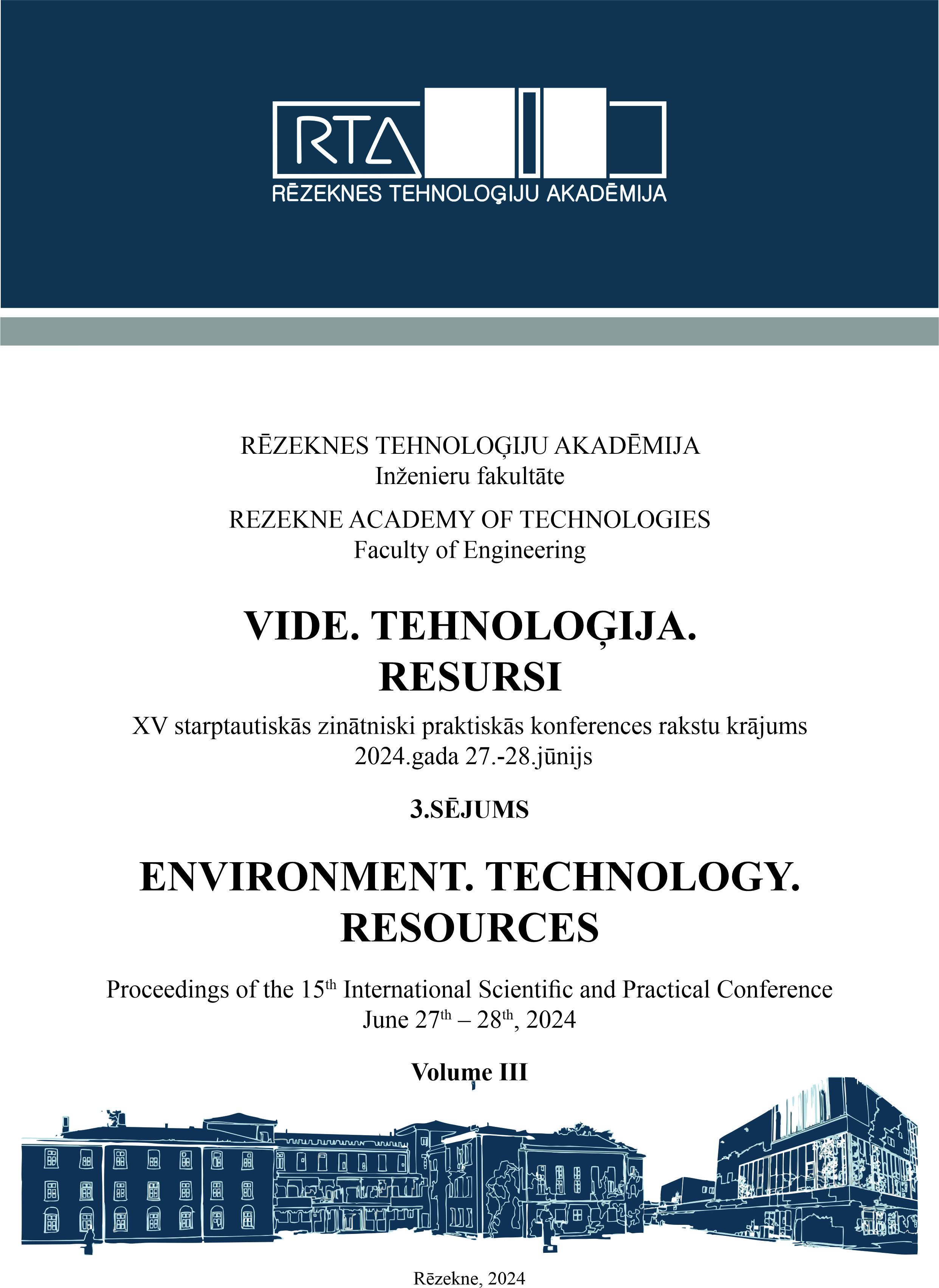LASER SURFACE MARKING ON ENGINEERING THERMOPLASTIC: POLYAMIDE
DOI:
https://doi.org/10.17770/etr2024vol3.8169Keywords:
laser marking, polyamide, laser parametrs, laser sourcesAbstract
Its style sheet. Marking on polyamide is an important process because this type of material is widely used in many industrial sectors. Also, laser marking is a popular and easily automated method. But materials like polyamide have several properties, such as white color, that make laser marking a complicated process. White color has low laser absorption, so good marking results are difficult to achieve. Different types and parameters of the laser system are used for marking polyamide. To improve the marking results on polyamide, auxiliary materials are often used, which are applied to the polyamide surface. However, the most promising ranges of marking parameters without incorporating auxiliaries on the polyamide surface are still unknown. Successful marking on polyamide requires a deep study of parameters and various conditions.
References
L. Lazov, Lyubomir, H. Deneva, P. Narica, “Laser Marking Methods”, Environment. Technology. Resources. Proceedings of the International Scientific and Practical Conference. 1., 2015,.108. https://doi.org/10.17770/etr2015vol1.221
L. Lazov, E. Teirumnieks, T. Karadzhov, N. Angelov, “Influence of power density and frequency of the process of laser marking of steel products,” Infrared Physics & Technology 116, 103783, 10, 2021 https://doi.org/10.1016/j.infrared.2021.103783
S.V. Gulak, A. I. Cherkashin, I. Balashov, V.Zarytskyi, Y.S. Kurskoy, Y.V. Zhdanova, “Laser marking system for plastic products” 2019 IEEE 8th International Conference on Advanced Optoelectronics and Lasers, 2019. https://doi.org/10.1109/caol46282.2019.9019422
L. Lazov, A. Snikeris, I. Balchev, E. Teirumnieks, “Laser marking and engraving of household and industrial plastic products,” Journal of Physics: Conference Series, vol. 1859, p.1-8, 2021, https://doi.org/10.1088/1742-6596/1859/1/012016
M.F. Koldunov, A.A. Manenkov, I.L. Pokotilo, “Efficiency of various mechanisms of the laser damage in transparent solids”, Quantum electron, 2002, vol. 32, No.7, pp. 623–628.
N. Angelov, L.Lazov, et al, Influence of pulse duration on the process of laser marking of CT80 carbon tool steel products, Laser Phys., 2021, 31 045601, DOI: 10.1088/1555-6611/abe5af
A.S. Gnatenko, Yu.P. Machekhin, Yu.S. Kurskoy, V.P. Obozna, “Providing mode locking in fiber laser”, J. Nano- Electron. Phys., vol.10, 2018.
J. Bosman, “Processes and strategies for solid state Q-switch laser marking of polymers”, Velden, The Netherlands, p.243-244, 2007.
A.S. Gnatenko, Y.P. Machechin, “Generation mode stability of a fiber ring laser”, Telecommunications and Radio Engineering, vol. 74, no.7, p. 641-648, 2015.
T. J. McKee, L. Toth, W. Sauerer, (1999). “Customized Decorating of Plastic Parts with Gray Scale and Multi-Color Images Using Lasers,” Coloring Technology for Plastics, p.295–300, 1999. https://doi.org/10.1016/B978-188420778-5.50038-3
Z. Jia, K. Zhao, W. Liu, J. Ma, L. Wang,“Nanosecond pulsed laser processing circuits on the copper clad polyimide,” International Journal of Machining and Machinability of Materials, vol.15, p.157-173, 2014. , https://doi.org/10.1504/IJMMM.2014.060547
E. Neiss, M. Flury, J. Fontaine, “Diffractive optical elements for laser marking applications,” Optical Sensors, vol. 7003, p. 1-8, 2008. https://doi.org/10.1117/12.779944
D.G.Waugh,J.Lawrence,P.Shukla,C.Chan,I.Hussain,H. C Man, G. C. Smith, “Laser surface treatment of polyamide and NiTi alloy and the effects on mesenchymal stem cell response,” Industrial Laser Applications Symposium, 2015, https://doi.org/10.1117/12.2182432
Z.Cao,G.Lu,H.Gao,Z.Xue,K.Luo,K.Wang,M.Luo, “Preparation and laser marking properties of poly (propylene)/molybdenum sulfide composite materials,” ACS omega,vol.6,p.9129-9140,2021. , https://pubs.acs.org/doi/abs/10.1021/acsomega.1c00255
L Lazov, E Teirumnieks, N Angelov, E Teirumnieka, “Methodology for automatic determination of contrast of laser marking for different materials”, ENVIRONMENT. TECHNOLOGIES. RESOURCES., Proceedings of the International, 7, 2019, DOI: 10.17770/etr2019vol3.4143
P. Chang, A. Bruntz, L. Vidal, P. Vetter, P. Roudot, L. Bua, … O. Soppera, “Laser Polymer Tattooing: A Versatile Method for Permanent Marking on Polymer Surfaces, ”Macromolecular Materials and Engineering, p.1-9, 2019. , https://doi.org/10.1002/mame.201900402
P. Narica, L. Lazov, A. Teilans, P. Grabusts, E. Teirumnieks, P. Cacivkins, “Method for color laser marking process optimization with the use of genetic algorithms”, ENVIRONMENT. TECHNOLOGIES. RESOURCES. Proceedings of the International, 2017, DOI: 10.17770/etr2017vol2.2607
N.S. Mustafa, et al., Ch CH Reviewing of general polymer types, properties and application in medical field. Int J Sci Res(IJSR),2016,5(8):212e221. https://doi.org/10.21275/art2016772
E.Bitay, “Laser markability of PVC coated automotive electric cables,” eXPRESS Polymer Letters, vol.13, p.379-389, 2019. , https://doi.org/10.3144/expresspolymlett.2019.31
R.M. Harris, “Coloring technology for Plastics, Plastics Design Library”, p.333-334, 1999.
W. Zhong, Z. Cao, P. Qiu, D. Wu,C. Liu, H. Li, H. Zhu, “Laser-Marking Mechanism of Thermoplastic Polyurethane/Bi2O3 Composites,” ACS Applied Materials & Interfaces, vol.7,p. 24142–24149, 2015. [Accessed February 19, 2024], https://doi.org/10.1021/acsami.5b07406
L.Sobotova, M. Badida, "Laser marking as environment technology" Open Engineering, vol. 7, p.303-316, 2017, https://doi.org/10.1515/eng-2017-0030
I.D. Savu, S.V. Savu, N.A. Sirbu, “Heat affected zones in polymer laser marking”, J Therm Anal Calorim, vol.115, p.1427–1437, 2014., https://doi.org/10.1007/s10973-013-3443-2
C. Shan Wang, J. Yueh Shieh, “Synthesis and flame retardancy of phosphorus containing polycarbonate,” Journal of Polymer Research, vol.6, p.149–154, 1999. , https://doi.org/10.1007/s10965-006-0082-3
A.P Ranade, A. Hiltner, E. Baer, D.G. Bland, “Structure-Property Relationships in Coextruded Foam/Film Microlayers, ”Journal of Cellular Plastics, vol.40, p.497–507, 2014. https://doi.org/10.1177/0021955x04048425
R. Wissemborski, R. Klein, “Welding and Marking of Plastics with Lasers,” Laser Technik Journal, vol.7(5), p.19–22, 2010. https://doi.org/doi:10.1002/latj.201090070
C.W. Bunn, E.V. Garner, “The Crystal Structures of Two Polyamides (’Nylons’),” Proceedings of the Royal Society A: Mathematical, Physical and Engineering Sciences, vol.189, p. 39–68, 1947., https://doi.org/10.1098/rspa.1947.0028
A.F. Obilor, et al., “Micro-texturing of polymer surfaces using lasers: a review”. Int J Adv Manuf Technol 120, 103–135 (2022). https://doi.org/10.1007/s00170-022-08731-1
G. Goldbach, M. Kita, K. Meyer, K.P Richter, “Structure and properties of polyamide 12 alloys, “ In: Springer, J. (eds) Polymers as Colloid Systems. Progress in Colloid & Polymer Science,vol.72,p.82-96,1985. https://doi.org/10.1007/BFb0114480
Downloads
Published
Issue
Section
License
Copyright (c) 2024 Anželika Litavnieka, Imants Adijāns

This work is licensed under a Creative Commons Attribution 4.0 International License.



